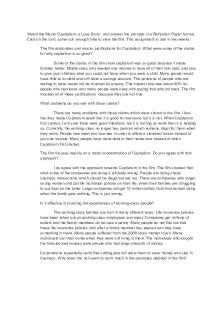English 1A03- A Coyote Columbus Story PDF

| Title | English 1A03- A Coyote Columbus Story |
|---|---|
| Author | Emily Vandehei |
| Course | Literature in English: Shorter Genres |
| Institution | McMaster University |
| Pages | 2 |
| File Size | 49.8 KB |
| File Type | |
| Total Downloads | 38 |
| Total Views | 145 |
Summary
Download English 1A03- A Coyote Columbus Story PDF
Description
English Short Genres- A Coyote Columbus Story -The Lone Ranger; an old American television show -Began with the Lone Ranger who was injured in a battle, another ranger comes back and nurses him back to health; then the lone ranger puts on this mask and goes around the country saving people/things -Lone Ranger is supposed to look like a hero -Why would native artists decide they want to take pictures with the mask on? –they wanted to look like a super hero (switch of roles; play a role they would not normally play) -Mask is normally a symbol of oppression, racism, etc. -“I’m aware of what you’ve done with this mask before and I’m going to give it some new meaning” A Coyote Columbus Understand the power of telling & retelling stories Recognize alternate ways of knowing, learning, evaluating and telling the truth A Story about Story-Telling Why do we tell stories? -Stories are windows to other perspectives -Stories often have a moral point to them -Keeps a nation or families historical traditions/values alive through story -Reinterpret ideas -A little bit of the story-teller becomes apparent in the story, through their telling -Different versions of stories Rewritten Story -There is always an original, then a new rewritten story -You need to read the original story before reading the rewritten version -Rewritten version will always point back to the original Inhabit the Story -Relationship where one story inhabits another -Inhabit is to live inside something -Stories are like houses; how they have a structure, living inside it and changing it, making the house yours, etc. -Narrative of Christopher Columbus’ story -Columbus has inhabited the story Make your mark and make it yours: possession is 9/10ths of the law Like the mask, a symbol of oppression that can be worn/inhabited/lived in, in order to shift perspective and power A Coyote Columbus Story -made up of a framed story; an outside story, something happens and the narrative tells the story and an interior story; a story a character tells -Narrator is going to tell Coyote the interior story about old Coyote -Both stories featuring a coyote figure
Frame Story
-Frame story; there are houses, characters who drink tea and tell stories; however does not represent our lives -Story about a world that we don’t live in -Coyote is a trickster figure that normally comes from legends -Interior Story -Old Coyote makes up all the rules -Power of re-telling stories: let go of our perspective and see things through new eyes -If you change stories or retell them, we make room for new perspectives, more opinions, different ways of telling the truth, stories have to change to ensure that people are thinking and thinking about different perspectives of the story -Chronological time does not seem to exist in this story -Things of the future in this story that don’t belong Where does knowledge come from (in the story)? -Coyote gets her knowledge of the history from a big, red history book -However the narrator learns from other people (oral versions though) -Narrator says the Coyote’s story of the Columbus story is bent/slanted -According to the narrator, you cannot trust written culture- only oral stories -King has written a story that sounds like an oral story -To call something a coyote story means somebody has played with the story, cannot fully be trusted- as stated by the narrator; bits of truth embedded -Each version of the story is tricky with the truth -“Bent Stories” (293) -“Tell all the truth but tell it slant.”- Emily Dickenson...
Similar Free PDFs

Matriz Batelle Columbus
- 4 Pages

Final Review - Music 1A03
- 22 Pages

Story Essay - Grade: A
- 8 Pages

Metodo Batelle- Columbus
- 7 Pages

Capitalism a Love Story
- 2 Pages

Linguistics 1A03 Project One
- 9 Pages

Exercise 1.2.2 Columbus Timeline
- 1 Pages

Building a story brand pdf
- 199 Pages

Story Diagnosis #1 - Grade: A
- 2 Pages

Short Story Essay - Grade: A
- 6 Pages
Popular Institutions
- Tinajero National High School - Annex
- Politeknik Caltex Riau
- Yokohama City University
- SGT University
- University of Al-Qadisiyah
- Divine Word College of Vigan
- Techniek College Rotterdam
- Universidade de Santiago
- Universiti Teknologi MARA Cawangan Johor Kampus Pasir Gudang
- Poltekkes Kemenkes Yogyakarta
- Baguio City National High School
- Colegio san marcos
- preparatoria uno
- Centro de Bachillerato Tecnológico Industrial y de Servicios No. 107
- Dalian Maritime University
- Quang Trung Secondary School
- Colegio Tecnológico en Informática
- Corporación Regional de Educación Superior
- Grupo CEDVA
- Dar Al Uloom University
- Centro de Estudios Preuniversitarios de la Universidad Nacional de Ingeniería
- 上智大学
- Aakash International School, Nuna Majara
- San Felipe Neri Catholic School
- Kang Chiao International School - New Taipei City
- Misamis Occidental National High School
- Institución Educativa Escuela Normal Juan Ladrilleros
- Kolehiyo ng Pantukan
- Batanes State College
- Instituto Continental
- Sekolah Menengah Kejuruan Kesehatan Kaltara (Tarakan)
- Colegio de La Inmaculada Concepcion - Cebu





